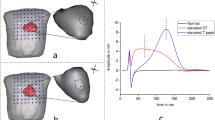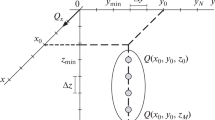Abstract
Cardiac current source reconstruction is investigated by a fast greedy sparse (FGS) method applied to simulated and real magnetocardiography (MCG) data measured using 61-channel superconducting quantum interference device. The approach reduces the size of the lead field matrix based on a priori knowledge of dipolar magnetic field map. Consequently, the computational demands and the accuracy of sparse source reconstruction are improved simultaneously. The simulation results demonstrate that the FGS method is capable of reconstructing sparse equivalent current sources using the magnetic field data generated by a single current source with varying orientation or multiple current sources generated randomly. In addition, we analyze the cardiac current source reconstructed with real MCG data at typical instants and discuss the electrical excitation conduction during the QRS complex based on moving sparse source imaging.



Similar content being viewed by others
References
Kaiboriboon K, Lüders HO, Hamaneh M et al (2012) EEG source imaging in epilepsy—practicalities and pitfalls. Nat Rev Neurol 8:498–507
Peña J, Marroquin J (2011) Region-based current-source reconstruction for the inverse EEG problem. IEEE T Bio-Med Eng 58:1044–1054
Hyde DE, Duffy FH, Warfield SK (2014) Voxel-based dipole orientation constraints for distributed current estimation. IEEE Bio-Med Eng 61:2028–2040
Lamus C, Hämäläinen MS, Temereanca S et al (2012) A spatiotemporal dynamic distributed solution to the MEG inverse problem. NeuroImage 63:894–909
Cohen D, Hosaka H (1976) Part II Magnetic field produced by a current dipole. J Electrocardiol 9:409–417
Hosaka H, Cohen D (1976) Part IV Visual determination of generators of the magnetocardiogram. J Electrocardiol 9:426–432
De Melis M, Tanaka K, Uchikawa Y (2010) Magnetocardiography signal reconstruction with reduced source space based on current source variance. IEEE Trans Magn 46:1203–1207
Bing L, Wang WY, Jiang SQ et al (2013) MCG source reconstruction based on greedy sparse method. Acta Phys Sin-Ch Ed 62:550–558 (in Chinese)
Van Leeuwen P, Hailer B, Beck A et al (2011) Changes in dipolar structure of cardiac magnetic field maps after ST elevation myocardial infarction. Ann Noninvas Electrocardiol 16:379–387
Baillet S, Mosher JC, Leahy RM (2001) Electromagnetic brain mapping. IEEE Signal Proc Mag 18:14–30
Blumensath T, Davis ME (2008) Gradient pursuits. IEEE Trans Signal Proces 56:2370–2382
Donoho DL, Tsaig Y, Drori I et al (2012) Sparse solution of underdetermined systems of linear equations by stagewise orthogonal matching pursuit. IEEE Trans Inform Theory 58:1094–1121
Needell D, Vershynin R (2009) Uniform uncertainty principle and signal recovery via regularized orthogonal matching pursuit. Found Comput Math 9:317–334
Simelius K, Stenroos M, Reinhardt L et al (2003) Spatiotemporal characterization of paced cardiac activation with body surface potential mapping and self-organizing maps. Physiol Meas 24:805–816
Stroink G, Lant J, Elliott P et al (1992) Discrimination between myocardial infarct and ventricular tachycardia patients using magnetocardiographic trajectory plots and iso-integral maps. J Electrocardiol 25:129–142
Acknowledgments
This work was supported by the National Natural Science Foundation of China (60771030), the National High-Technology Research and Development Program of China (2008AA02Z308), the Shanghai Science and Technology Development Foundation (08JC1421800), Shanghai Leading Academic Discipline Project (B004), the Open Project of State Key Laboratory of Function Materials for Information (Shanghai Institute of Microsystem and Information Technology, Chinese Academy of Sciences).
Author information
Authors and Affiliations
Corresponding author
Ethics declarations
Conflict of interest
The authors declare that they have no conflict of interest.
About this article
Cite this article
Chen, M., Jiang, S., Bing, L. et al. Sparse current source reconstruction in MCG. Sci. Bull. 60, 1235–1240 (2015). https://doi.org/10.1007/s11434-015-0845-5
Received:
Accepted:
Published:
Issue Date:
DOI: https://doi.org/10.1007/s11434-015-0845-5




